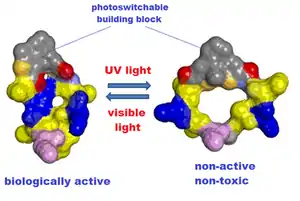Photoactivated peptide
Photoactivated peptides are modified natural or synthetic peptides the functions of which can be activated with light. This can be done either irreversibly or in a reversible way. Caged peptides [1] which contain photocleavable protecting groups belong to irreversibly activated peptides. Reversible activation/deactivation of peptide function are achieved by incorporation photo-controllable fragments (molecular photoswitches) in the side chains or in the backbone of peptide templates to get the photo-controlled peptides, which can reversibly change their structure upon irradiation with light of different wavelength. As the consequence, the properties, function and biological activity of the modified peptides can be controlled by light. Since light can be directed to specific areas, such peptides can be activated only at targeted sites. Azobenzenes,[2][3][4] and diarylethenes[5][6] can be used as the photoswitches. For therapeutic use, photoswitches with longer wavelengths (near-infrared, to penetrate tissue) or the use of two-photon excitation[7] are required, coupled with improved methods for peptide delivery to live cells.[8][9]


Applications
Photoactivated peptides are potentially useful for cancer therapy, other light-controlled drugs and in tools to probe molecular interactions in intact cells and whole organisms.[8]
The initial peptides were successfully used to kill B-cell lymphoma cancer cells. The reference synthetic short peptide was alkylated with azobenzene crosslinkers and used to photo-stimulate mitochondrial membrane depolarization and cytochrome c release in permeabilised cells, which were the initial events of the intrinsic apoptosis pathway.[8] Gramicidin S analogues containing a diarylethene fragment[6] display clear-cut reversible change of antimicrobial activity. In an inactive, UV-inducible photo-form they are harmless to bacteria cells, but are bactericidal after the activation with visible (amber) light.
See also
- Photochromism
- Azobenzene
- Spiropyran
- Diarylethene
- Photodynamic therapy
- Bcl-2
- Bak (Bcl-2 homologous antagonist killer)
- Bid (BH3 interacting-domain death agonist)
- Luis Moroder, G. Andrew Woolley, Rudolf K. Allemann, Jean Chmielewski
References
- N. Umezawa; Y. Noro; K. Ukai; N. Kato; T. Higuchi. (2011). "Photocontrol of Peptide Function: Backbone Cyclization Strategy with Photocleavable Amino Acid". ChemBioChem. 12 (11): 1694–1698. doi:10.1002/cbic.201100212. PMID 21656633.
- Abell, A.D.; et al. (2007). "Investigation into the P3 binding domain of m-calpain using photoswitchable diazo- and triazene-dipeptide aldehydes: new anticataract agents". J. Med. Chem. 50 (12): 2916–2920. doi:10.1021/jm061455n. PMID 17497840.
- J. Kuil; L.T.M. van Wandelen; N.J. de Mola; R.M.J. Liskamp (2009). "Switching between low and high affinity for the Syk tandem SH2 domain by irradiation of azobenzene containing ITAM peptidomimetics". J. Pept. Sci. 15 (10): 685–691. doi:10.1002/psc.1173. PMID 19714714.
- G. A. Woolley; A. S. I. Jaikaran; M. Berezovski; J. P. Calarco; S. N. Krylov; O. S. Smart; J. R. Kumita (2006). "Reversible Photocontrol of DNA Binding by a Designed GCN4-bZIP Protein". Biochemistry. 45 (19): 6075–6084. CiteSeerX 10.1.1.555.8745. doi:10.1021/bi060142r. PMID 16681380.
- K. Fujimoto; M. Kajino; I. Sakaguchi; M. Inouye (2012). "Photoswitchable, DNA-Binding Helical Peptides Assembled with Two Independently Designed Sequences for Photoregulation and DNA Recognition". Chem. Eur. J. 18 (32): 9834–9840. doi:10.1002/chem.201201431. PMID 22767420.
- O. Babii; S. Afonin; M. Berditsch; S. Reiβer; P. K. Mykhailiuk; V. S. Kubyshkin; T. Steinbrecher; A. S. Ulrich; I. V. Komarov (2014). "Controlling Biological Activity with Light: Diarylethene-Containing Cyclic Peptidomimetics". Angew. Chem. Int. Ed. 53 (13): 3392–3395. doi:10.1002/anie.201310019. PMID 24554486.
- Zhang, Y Erdmann, F Fischer, G (2009). "Augmented photoswitching modulates immune signaling". Nature Chemical Biology. 5 (10): 724–726. doi:10.1038/nchembio.214. PMID 19734911.CS1 maint: multiple names: authors list (link)
- Mart, Robert J.; Errington, Rachel J.; Watkins, Catherine L.; Chappell, Sally C.; Wiltshire, Marie; Jones, Arwyn T.; Smith, Paul J.; Allemann, Rudolf K. (2013). "Light triggers cancer death switch". Molecular BioSystems. 9 (11): 2597–603. doi:10.1039/C3MB70246D. PMID 23942570. Retrieved 2013-10-18.
- Mart, R. J.; Errington, R. J.; Watkins, C. L.; Chappell, S. C.; Wiltshire, M.; Jones, A. T.; Smith, P. J.; Allemann, R. K. (2013). "BH3 helix-derived biophotonic nanoswitches regulate cytochrome c release in permeabilised cells". Molecular BioSystems. 9 (11): 2597–2603. doi:10.1039/C3MB70246D. PMID 23942570.